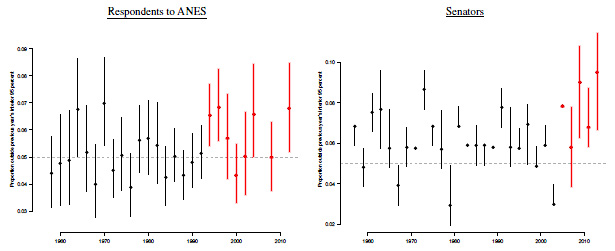Over at the Monkey Cage, political scientists Seth Hill and Chris Tausanovitch argue that despite what it looks like, the American public hasn’t actually gotten more polarized over the past 50 or 60 years. Lawmakers have, but ordinary citizens haven’t.
But I’m not sure their own data backs this up. Unfortunately, the chart I want to talk about is a little complicated, so bear with me. The authors measure polarization by looking at answers to questions on the American National Election Studies survey, which is conducted every two years. In the chart below, they look at what percentage of respondents are as extreme as the most extreme 5 percent from the previous survey. If it’s 5 percent, then nothing has changed. If it’s 6 percent, then the relative number of extremists has gone up. Here’s the chart:

The thing to notice is that these changes are cumulative because each year is measured relative to the previous survey. Take a look at the left-hand chart, which measures the polarization of ordinary people. Just by eyeballing and adding up the differences from 5 percent,1 I get a cumulative change of +0.7 percent between 1956 and 1992. That’s a change of +0.02 percent per year, which is virtually nothing.
But if you add up the years between 1994 and 2012 (in red), you get a cumulative change of about 6.6 percent. That’s a change of +0.4 percent per year.
For senators, the story is a little different. They’ve been getting steadily more polarized all along, but in 2004 the changes get much bigger, with no low points and certainly no negative points.
But it’s ordinary people that I want to focus on. The authors look at the entire period from 1956-2012 and see little evidence of increased polarization. I think this misreads things. There’s little evidence of consistently increasing polarization through 1992. But starting in 1994, which coincides with the Gingrich revolution, polarization gets steadily stronger. (For some reason there’s no data for 2006 and 2010, but I suspect those are years of increasing polarization anyway.) It may be true that Congress has gotten even more polarized than the public—partly because of ideological sorting and partly because politicians tend to take politics more seriously—but ever since 1994 the public has indeed been getting more polarized too.
1This is not the right way to measure cumulative change, but it’s good enough to make my point. I think you’d see the same thing if you did the arithmetic correctly.














